Trees for winter interest
Enhancing your landscapes with trees that offer year-round appeal
Winter can be an uninteresting time in gardens, without the colours of blooming flowers, or the dense green foliage that is present throughout the rest of the year. A garden’s core structure and design is important in any season, but it becomes more apparent in winter. It’s a season where the landscape presents a challenge to the designer.
As winter arrives and the temperature drops, the green foliage of spring and summer falls away to expose bare branches and this can leave many gardens looking uninspiring. However, key plants can provide visual interest during this colder season, through their evergreen foliage, winter flowers, fruit, and berries.
Thoughtful plant selection can provide appeal to the garden throughout the seasons, transforming it into a changing canvas as the colder months arrive.
Understanding the characteristics of plants is essential in designing a garden that evolves with the changing seasons. Evergreen plants provide consistency, and year–round colour. Carefully selected deciduous shrubs can bring a garden to life in winter with new colour and structure. Building on this foundation, smaller plants can be chosen to complement and enrich the overall visual appeal.
In this blog we look at trees that are hardy enough to endure the winter, but also bring a touch of year-round interest to our gardens. Winter doesn’t have to mean a dormant garden; it can be filled with colours of carefully chosen plants and trees in every season.
Seasonal strategies: the adaptation of evergreen and deciduous trees
Tree species can be divided into two broad categories based on their ability to adapt to the changing seasons. Evergreen varieties, such Pinus sylvestris, Taxus baccata, or Prunus lusitanica continually renew their leaves throughout the year. These evergreens thrive in coastal or low-altitude environments, where even winter temperatures remain relatively mild. Whereas deciduous trees, like Cornus or Acer, typically shed their leaves in autumn, baring their branches during the harsh winter months. This helps the trees survive in higher altitudes or regions with more challenging winter conditions.
Contrary to common belief, evergreen plants do shed their leaves, they just don’t shed them all at once like their deciduous counterparts. Evergreens keep their leaves year-round, even in the colder seasons of our climates, or the dry periods of exceptionally hot climates. Typically, they shed their oldest leaves gradually, often alongside the development of new buds. In some instances, a single leaf can live for several years, showcasing the longevity of their foliage. This trait is particularly prevalent in environments with extreme temperatures, compensating for lower soil nutrient levels by allowing continuous photosynthesis and the accumulation of reserve substances.
Deciduous trees, instead, shed all their leaves simultaneously, usually in autumn as the cold season approaches. However, in tropical, sub-tropical, and arid regions, leaf drop aligns with the onset of the dry season and reduced rainfall. The deciduous cycle, influenced by the changing environmental conditions, demonstrates the adaptability of these trees on a global scale.
There are deciduous plants that reveal their most intriguing characteristics when they lose their leaves in winter. Among these, the Salix viminalis is prominent, with its slender orange/red twigs, bringing a warm and vibrant tone. Similarly, Cornus sanguinea ‘Winter Flame’, alongside the Cornus alba, are intriguing beneath their season foliage. Acer palmatum ‘Corallinum’ features striking pink branches.
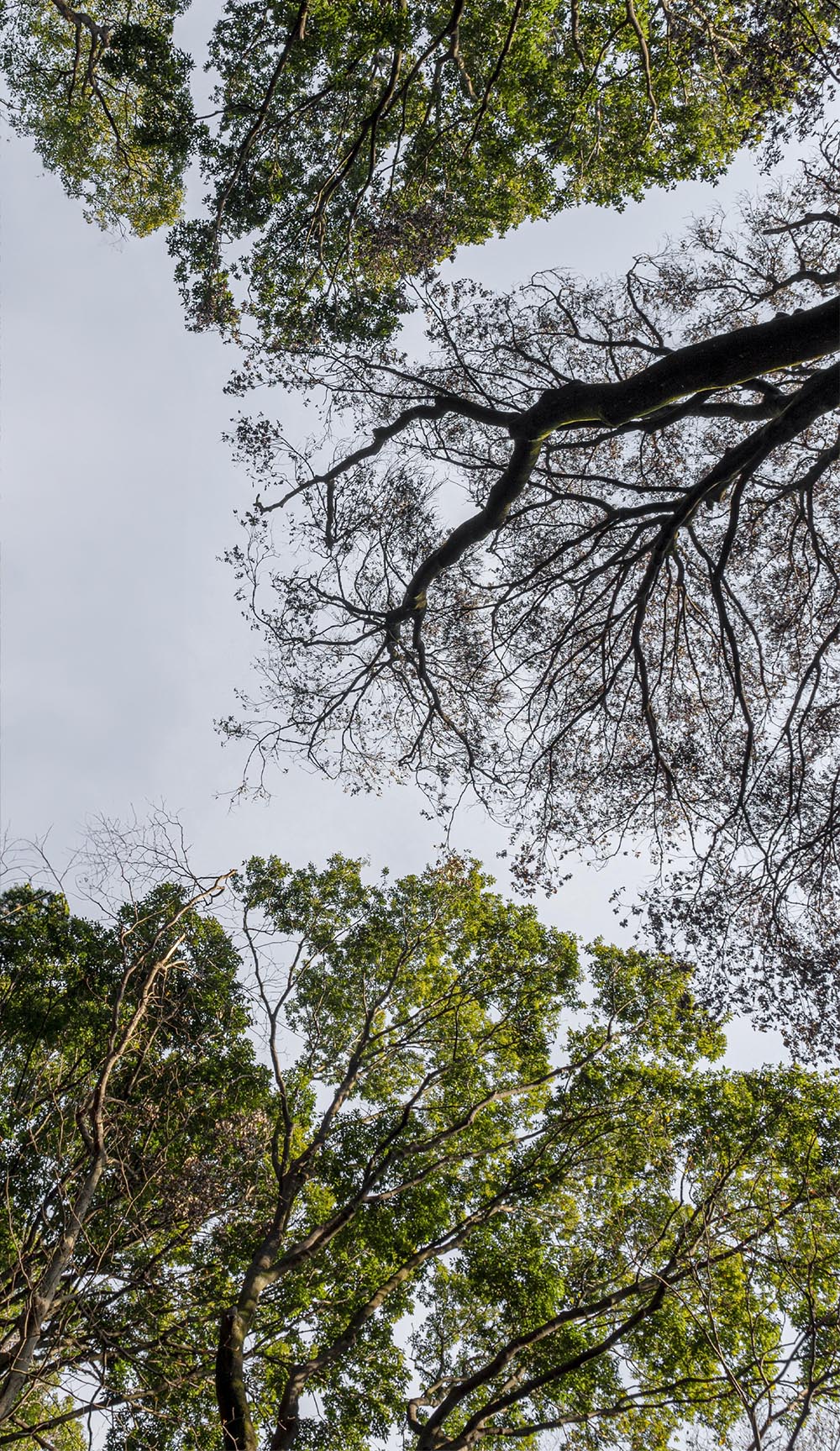
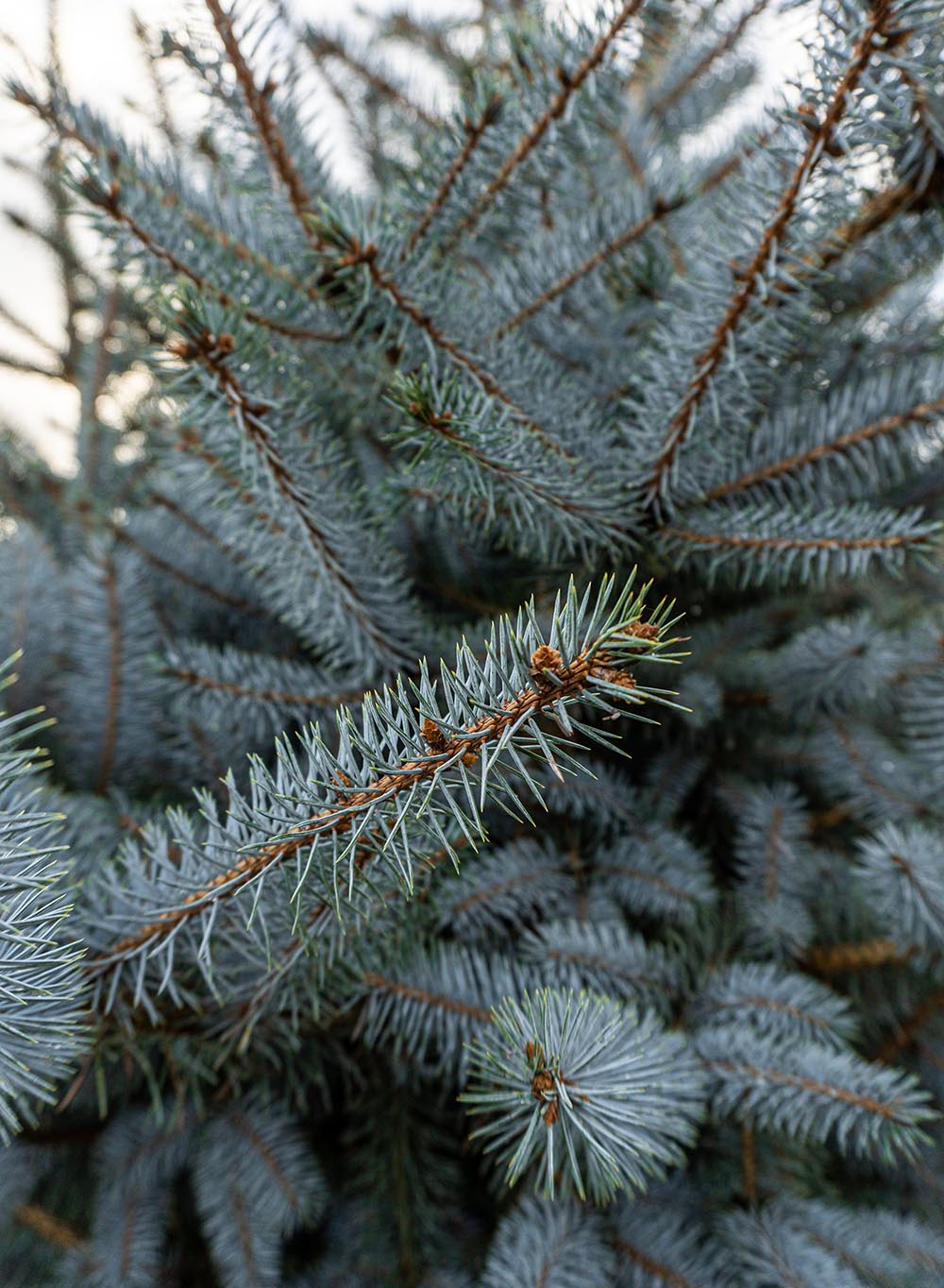
Picea pungens ‘Blue Diamond’
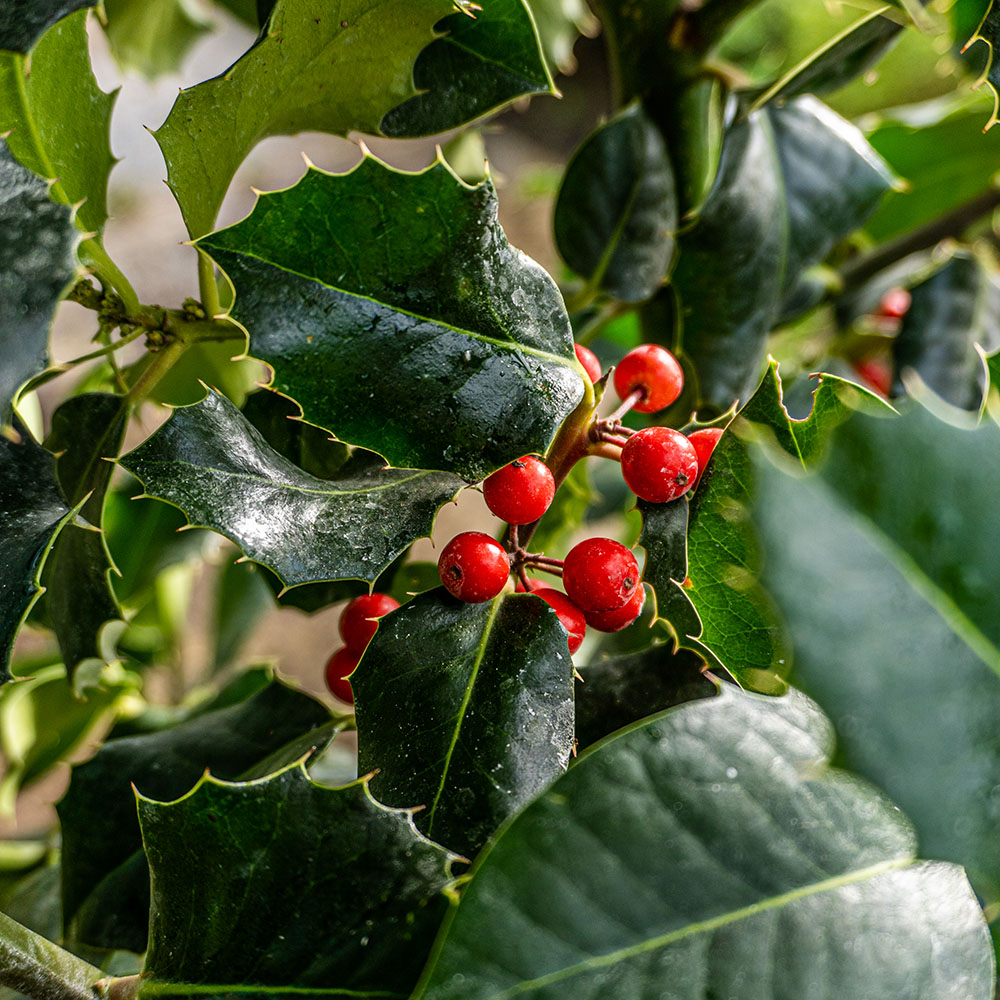
Ilex aquifolium
Evergreen Trees
Picea pungens
Known for its appealing looks, the Picea pungens is an evergreen conifer that adds a touch of elegance, especially during winter. It has distinctive blue and silver colouring, and a pyramid shape reaching up to 10 meters. With rigid quadrangular needles in a white-blue hue. During winter, the Picea pungens is a reliable source of colour, contributing to the garden’s visual interest. Resistant to cold temperatures, it adapts well to various climates, making it suitable for ornamental landscaping or as a classic Christmas tree. To ensure strong growth, it prefers a well-drained substrate and regular watering, especially in the summer months.
Ilex aquifolium
Widely known for its association with Christmas, Ilex aquifolium, commonly referred to as holly, is a member of the Aquifoliaceae family. Recognisable by its robust and sharply edged bright green leaves, this evergreen shrub stands out with its pyramidal foliage, smooth grey bark, and greenish branches, reaching heights of up to 10 meters. The characteristic dark green leaves, occasionally adorned with streaks of white, cream, or yellow, bear bright red berries, serving as seeds during this period. Toxic to humans but attractive to birds, the red berries play a crucial ecological role. Thriving in shaded, cool environments with minimal water and good ventilation, holly’s resilience extends to various soil types. Whether in gardens or potted settings, its enduring beauty, especially in winter, adds elegance to outdoor spaces.
To learn more about Ilex, read our blog ‘Focus on: Ilex’ for a comprehensive insight.
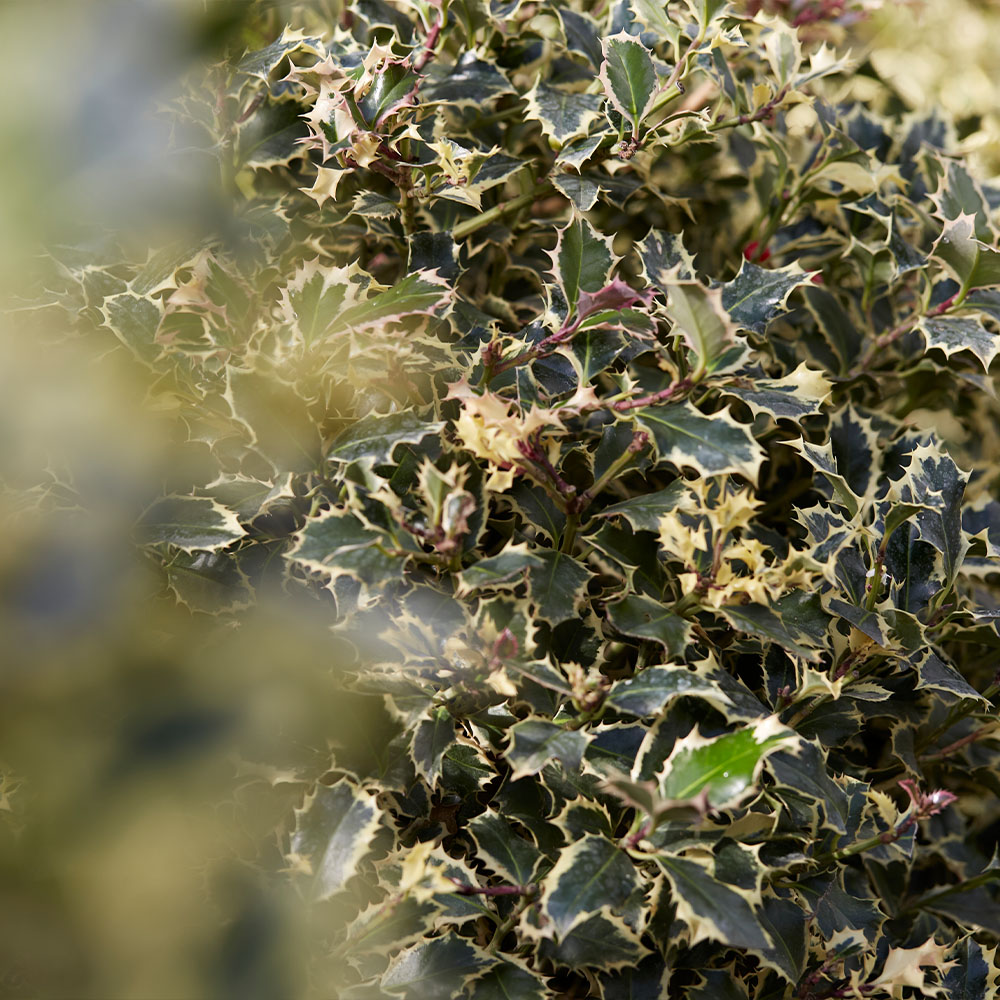
Ilex aquifolium ‘Argentea Marginata’
Photinia x fraseri ‘Red Robin’
Photinia x fraseri ‘Red Robin’ stands out in winter, making it a practical choice for each winter garden. With its compact size and bold red foliage, it becomes a focal point in winter landscapes, whether in hedges or as a small tree. ‘Red Robin’ offers a colourful interest during the colder months.
This horticultural hybrid, a cross between Photinia glabra and Photinia serratifolia, features resilient red leaves that change from lively red in new growth to rich purple in summer and green in winter. Adaptable to various settings, it thrives in both sunny and partially shaded spots, resisting cold and urban smog.
‘Red Robin’ ensures more than just winter colour; it provides year-round interest. The leathery, oval leaves start as bright purple-red and mature into a lively dark green. As a frost-resistant shrub, it can handle temperatures as low as -5 °C, making it a reliable choice in different climates. Planted in well-drained, medium-fertile soils and sheltered from harsh winter winds.
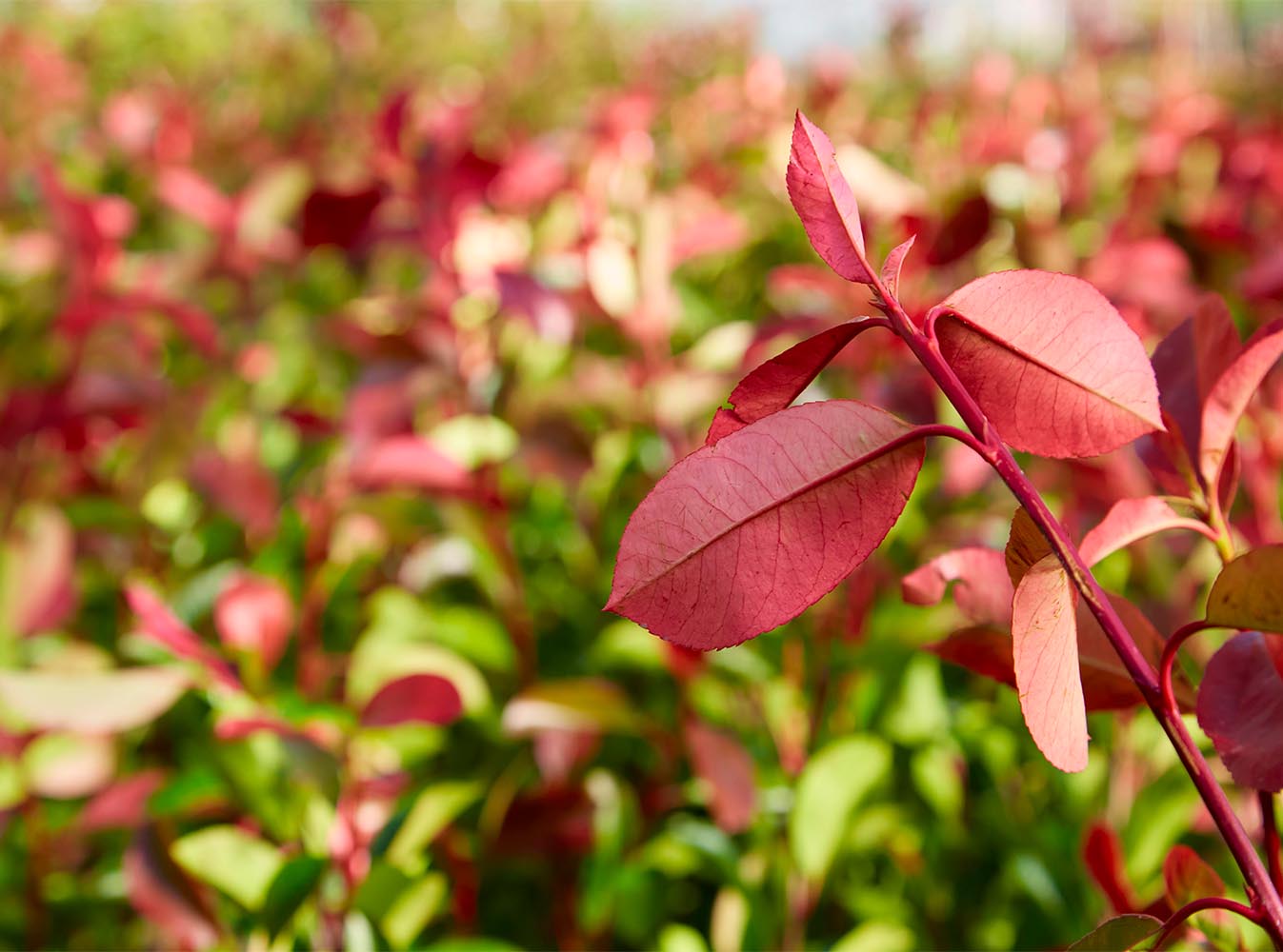
Photinia × fraseri ‘Red Robin‘
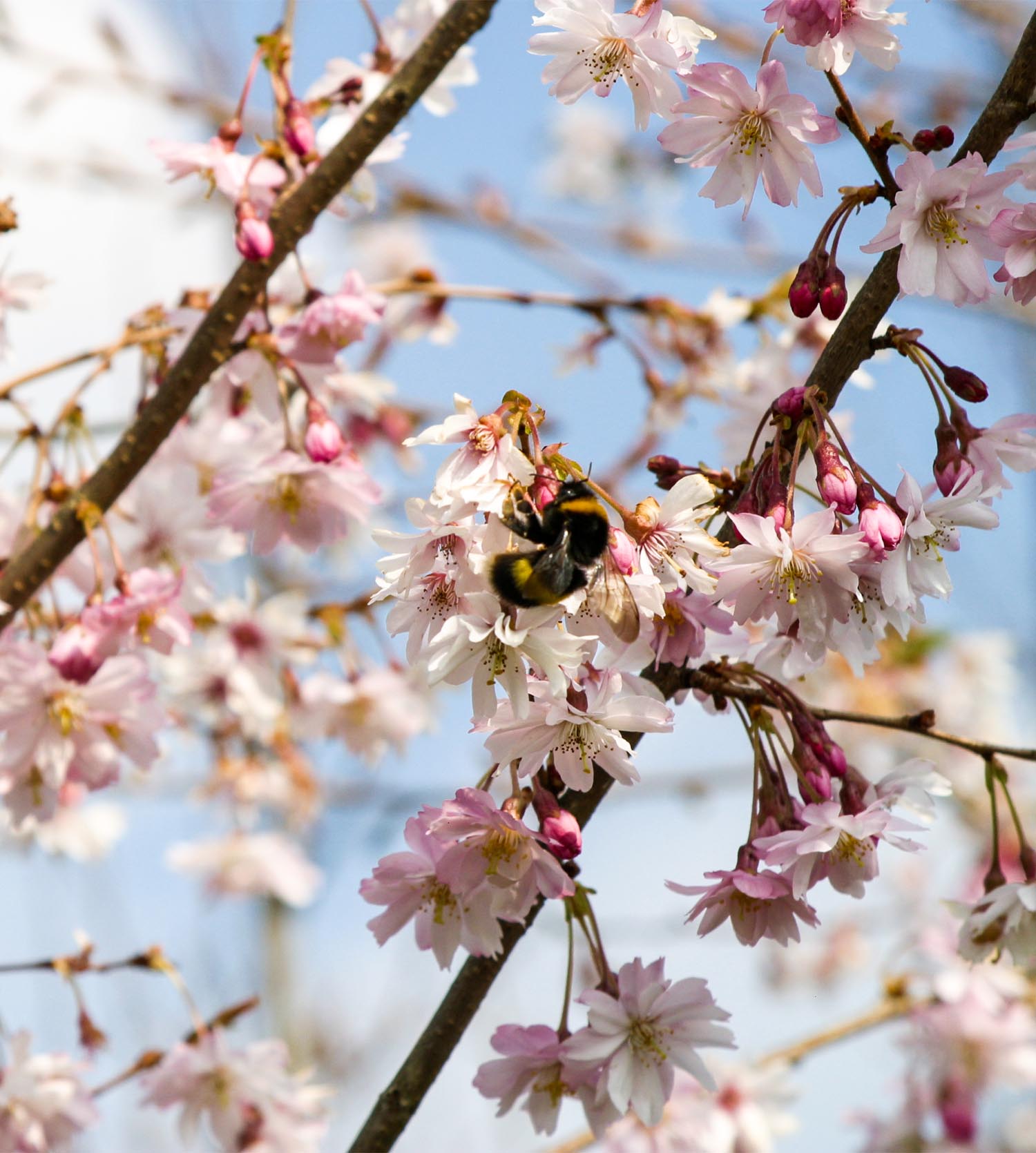
Prunus x subhirtella ‘Autumnalis Rosea’
Deciduous Trees
Prunus × subhirtella ‘Autumnalis Rosea’
Prunus × subhirtella ‘Autumnalis Rosea’ is an ornamental cherry, that produces delicate flowers from November to April, reaching full bloom in February.
This Japanese hybrid, resulting from the fusion of Prunus incisa and Prunus spachiana, stands as a small deciduous tree with a wide, airy habit. Its thin, arching branches carry ovate leaves that change from bronze in spring to dark green, turning bright yellow in autumn. Pale pink clusters of flowers develop from November-December, and last until April, accompanied by small purple fruits, providing food for birds. Recognised with the prestigious Garden Merit by the Royal Horticultural Society, ‘Autumnalis Rosea’ forms an intricate, lacy dome when in full bloom, creating an attractive vision when observed from below.
While extensively included in city gardens for its enduring winter flowering, the Prunus faces challenges in regions with excessively hot summers. Climate change has diminished its suitability for many urban areas experiencing scorching summers.
Adaptable to various soil types, ‘Autumnalis Rosea’ thrives in well-draining and moderately fertile conditions, with a preference for slightly acidic pH. It tolerates slight drought and flourishes equally in full sun or partial shade.
Sorbus aucuparia
Sorbus aucuparia is a tree known for its winter interest, with an abundance of fruits on its branches. Despite being deciduous, it retains its small berries, just over 1cm in size, throughout the winter. These rounded and fleshy fruits, appearing in scarlet red bunches when ripe, endure the cold season. While their sour taste may not appeal to human palates, they provide nourishment for wildlife. Crows, blackbirds, thrushes, and small mammals find these fruits to be essential sources of nutrition, contributing to the plant’s widespread reproduction.
Beyond its winter offerings, Sorbus aucuparia is a deciduous tree, reaching up to 15 meters in height, or it is also used as bushy shrub. With its erect shape, slender stem and smooth, shiny grey bark, this tree produces rounded foliage with ascending horizontal branches during warmer months. The leaves, alternately arranged with short petioles, consist of numerous pairs of oblong-shaped leaflets with acute apexes and serrated margins.
In addition to bearing fruits, Sorbus aucuparia has numerous and fragrant flowers gathered in terminal corymbs, measuring up to 15 cm in size. Each flower showcases a calyx with triangular laciniae that curve inwards after flowering. The corolla reveals white, oval petals adorned with numerous stamens at its centre.
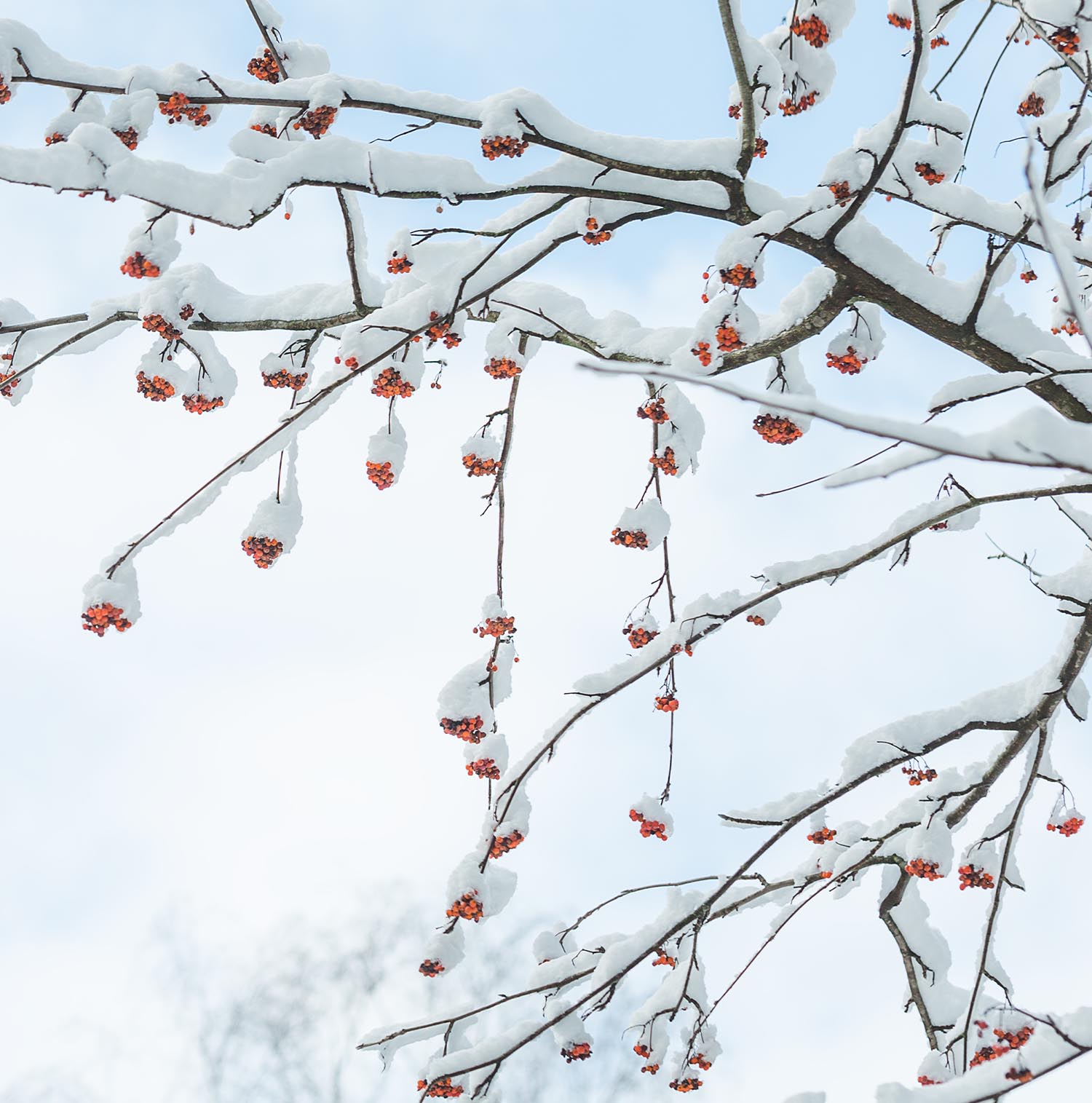
Sorbus aucuparia
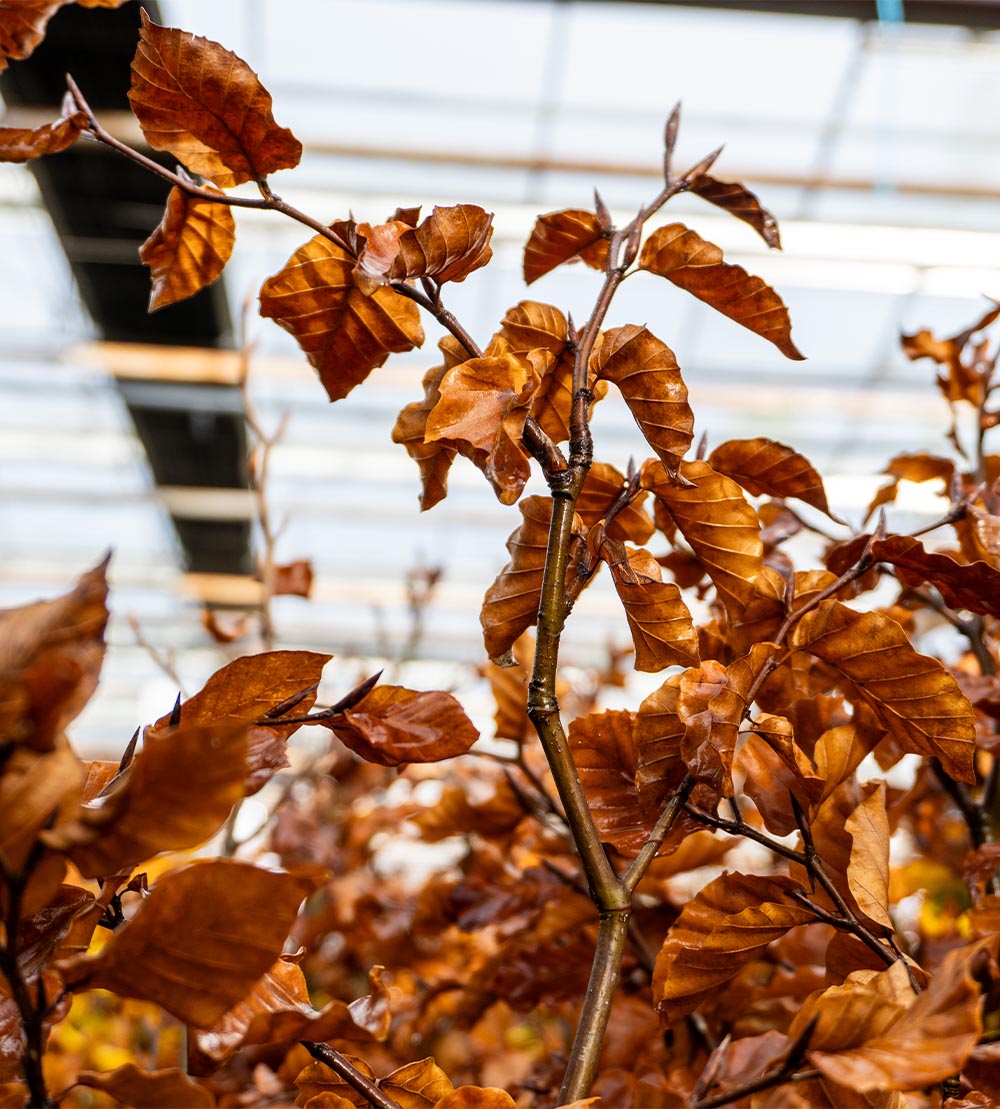
Fagus sylvatica
Fagus sylvatica
Fagus sylvatica is another deciduous tree with intriguing winter appeal. With a rounded shape and a potential height of 15 meters, this tree is characterised by medium, oval, sharp, and shiny leaves adorned with ribs and silky-haired peduncles. The tree maintains a lush, dense foliage throughout its life, with dry leaves persisting on the branches until the end of winter, adding a unique visual dimension to the winter landscape.
In autumn, the leaves of Fagus sylvatica change to golden-yellow, before turning to brick red/pink as chlorophyll dissipates. Unlike many deciduous trees, Fagus sylvatica tends to retain its leaves during winter, except in cases of severe frost or in areas above 1000 meters. This exceptional trait infuses gardens with vibrant colours and warm autumnal tones even in the midst of winter.
As the tree matures, the tree may shed its leaves more easily in winter, compared to a younger equivalent. Despite this, the Fagus sylvatica displays remarkable cold resistance, favouring colder climates over warmer ones. The tree flowers in spring between April and May, and adds another layer of visual appeal to its yearly cycle.
Fagus sylvatica reveals adaptability to various soil conditions, thriving in fresh soil rich in organic matter. While it cannot tolerate heavy, clayey soils leading to water stagnation, it can adapt to poorer soils as long as drought conditions are avoided.
Cornus
Plants within the Cornaceae family are distinctive in winter, with their branches, often red or yellow in colour, providing striking visual interest.
Cornus, while technically classified as ashrub rather than a tree, it undergoesa striking transformation during winter. The young stems of Cornus alba are a vibrant red hue, while Cornus sanguinea displays reddish-brown stems, and the branches of Cornus stolonifera are a dull red. A unique exception is Cornus stolonifera ‘Flaviramea’ with its green-yellow stems. During the warmer months, these shrubs also boast large, oval-shaped foliage. In the case of Cornus alba, the foliage takes on a red-orange hue in the autumn, with variegated options like Cornus alba ‘Elegantissima’ offering a white touch.
While the flowers in late spring may not be visually striking by comparison, their white blossoms are appreciated by bees and other pollinators. These shrubs, well-suited for forming patches either alone or in conjunction with other branch dogwoods, thrive in various climates. Resilient to harsh conditions, all varieties of Cornus adapt to diverse soils and can be planted in full sun or partial sunlight exposure.
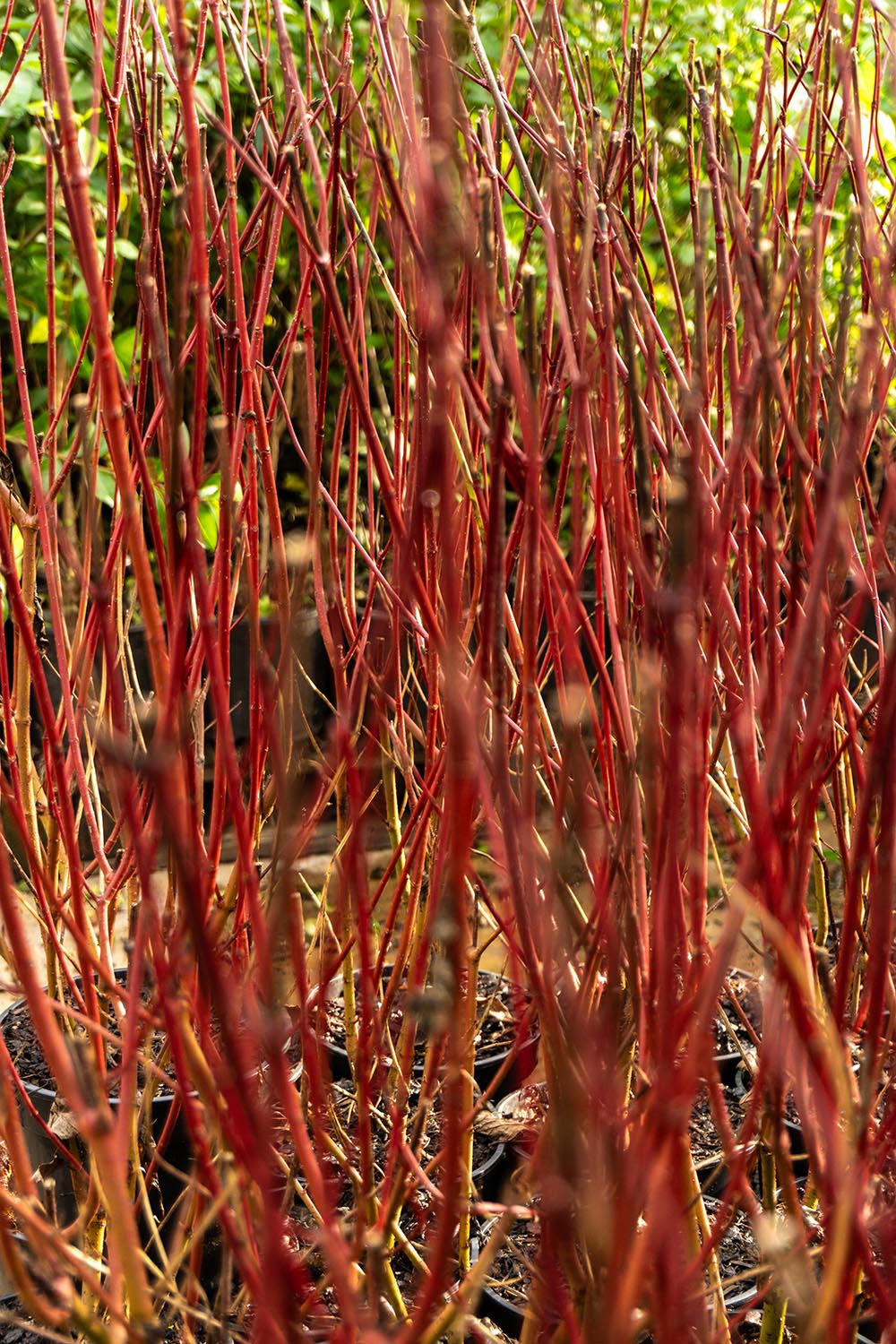
Cornus alba ‘Elegantissima’
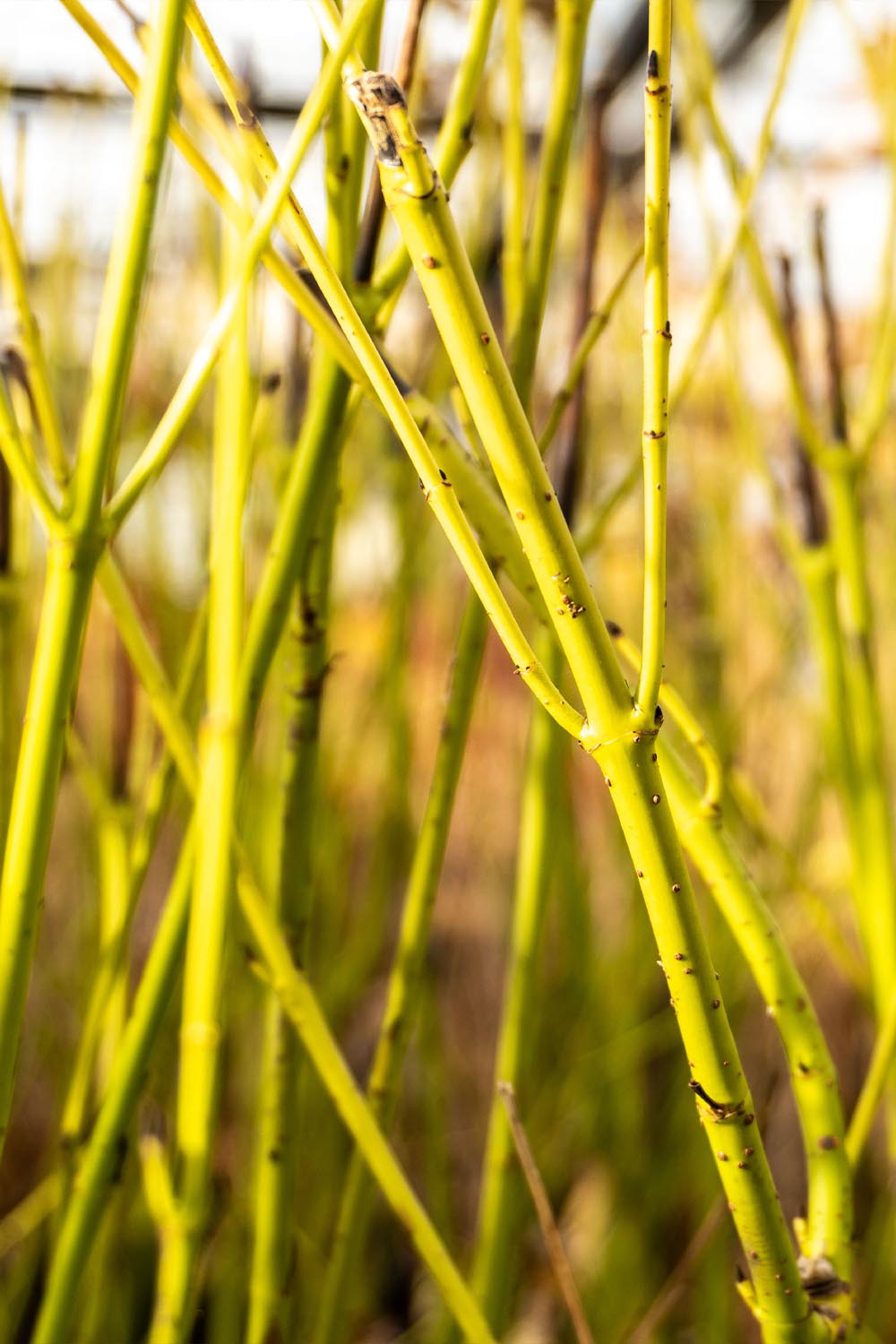
Cornus stolonifera ‘Flaviramea’
Get in touch with our expert G Team if you need advice on plants with winter interest, or head to our innovative Tender Tool app to get a quick and easy quote.

